#snakes of africa
Explore tagged Tumblr posts
Text
Snakes of Africa: Ball Pythons
This is the first of a series on African snake species, where I go through how they live in the wild and attempt to demystify some aspects of care and myths surrounding African snakes.
We all know the myths about ball pythons. They're from "a narrow strip in Africa," they don't need to climb, they don't need really high humidity...let's challenge some of those ideas!
If you don't know just how big Africa is, it's easy to underestimate how big the ball python's range is, too. I think it's easier to understand if you look at it on a global map:

That's a big area! Wild ball python habitats range from grasslands to forests, cutting through arid savannahs and even into rainforests.
Because the climate across the ball python's range is so variable, they are best understood as habitat generalists - they have perimeters they prefer, and they can find ways to adapt in different environments.
A large portion of the ball python's range is arid, and that leads to one famous fact about them: ball pythons love termite mounds, because they provide them with a nice and very humid area to nap. Even among people who know wild ball pythons love termite mounds, that's often used as reason to justify keeping them in too-small enclosures. After all, termite mounds don't sound like they're very big...
But they are.
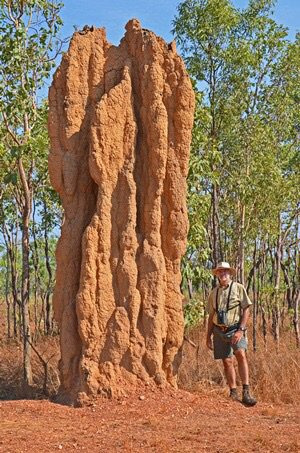
Termite mounds are one of the reasons ball pythons are such good climbers.
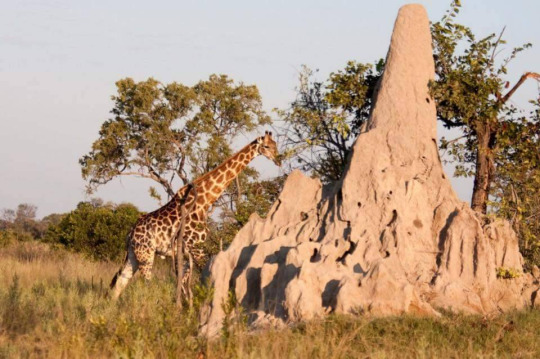
Despite their arid habitat, wild ball pythons (aside from seeking out termite mounds) will also seek out wet areas, such as streams and lakebeds. In captivity, humidity isn't something you should skimp on for a ball python. At least 60% humidity is essential, and closer to 70% is ideal, and a humidity box allows your snake to have an area that's close to 100% humidity at all times. Humidity boxes also allow for a range of humidity conditions, like your snake would experience in the wild!
An extremely common myth about ball pythons is that they don't climb and won't take advantage of enrichment. This couldn't be further from the truth! In the wild, ball pythons are excellent climbers and are known to even hunt in trees. Multiple studies surveying wild ball pythons have found nearly half of their subjects in trees. These are not solely terrestrial snakes.
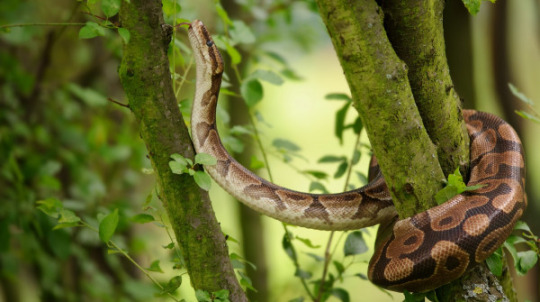
Another stereotype about ball pythons is that they're "pet rocks." If you give them enrichment and look at their wild behavior, this couldn't be further from the truth! Wild ball pythons are observed as being very active snakes who will actively hunt and seek out food rather than relying on strict ambush predation strategies. That's one reason it's best to feed your pet ball python when you see them out and "hunting!"
Of course, wild snakes will be more active than pet snakes simply for the sake of survival, but their activity level in the wild is indicative of what it should be more like in captivity. Some inviduals are a bit lazy, sure, but by and large most ball pythons will take advantage of every inch of space you give them. Climbing branches, tunnels, and new things to check out are a must!

Because wild ball pythons are habitat generalists, that also clues us into what enrichment they most enjoy. In the wild, along with climbing (which they love!), ball pythons are also known to swim (though they mostly only due this when necessary) and dig burrows. In captivity, many pet ball pythons enjoy an occasional soak, so it's good to provide a big enough water dish for them to curl up in, and some individuals enjoy digging burrows. If you provide an extra few inches of substrate for your snake to dig in, you might be surprised by how much they enjoy it!

Now, let's talk about food! In the wild, ball pythons eat a wide variety of rodents and a lot of birds. In fact, their semi-arboreal habits mean they even eat a lot of bats when they can catch them! Unfortunately, one of the tricky things about their diet is that their favorite foods in the wild include shrews, jerboas, African soft-furs, rufous-nosed rats, and other rodents that are just honestly impossible to source for your pet ball python. In captivity, a diet of rats is appropriate, and unfortunately it can be hard to provide variety to many ball pythons simply because a lot of them just prefer more hard-to-find rodents and will resist switching back to rats. For good, non-picky eaters, though, other rodents and chicks make excellent treats.
Ball pythons have a reptutation as very picky, finicky eaters, but honestly it's my experience that this effect is much, much lesser when their husbandry is consistently appropriate. Making sure to provide adequate humidity seems especially important in ensuring your ball python is a good eater! Additionally, ball pythons tend to like it a bit hotter - 90 F (32 C) is a good hot-side temperature for most ball pythons.
If there's anything to take away from this brief look into wild ball pythons, it's this: these snakes will thrive best if given the opportunity to engage in more natural behaviors. Climbing, digging, and exploring are essential for any ball python!
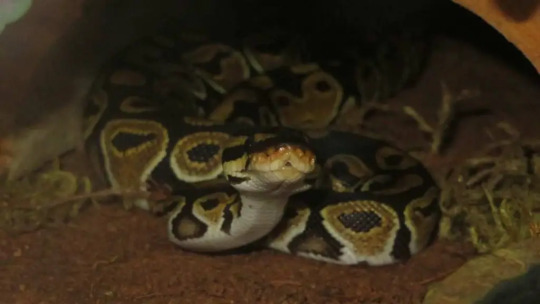
Ball pythons are so much more than just "pet rocks." If you provide them with space and enrichment, you'll be delighted by what fun, active, curious, and engaging pets they are!

(This message is approved by my sweet girl Miriam.)
537 notes
·
View notes
Text

Common Egg-eating Snake (Dasypeltis scabra), family Colubridae, South Africa
photograph by Cristian Schneider
38K notes
·
View notes
Text
" West African Bush Viper " //© Severus Snakes
Music: © Giulio Cercato - Echoes Of Us
#West Africa#Africa#nature#Portraits#Wildlife#Snakes#Bush Viper#4K#8K#12K#fpv#reels#photography#aesthetics#wanderlust#explore#follow#discover
284 notes
·
View notes
Text

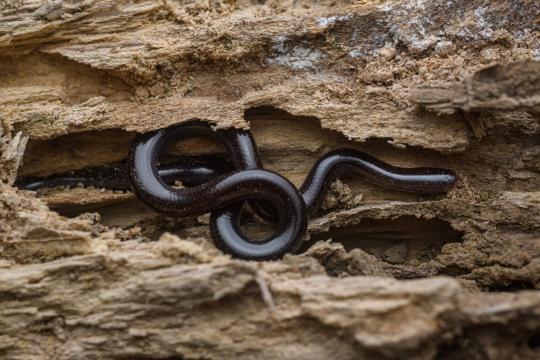

Brace Yourself for the Brahminy Blind Snake
Also known as the flowerpot snake, the Kurudi snake, or the Sirupaambu snake, the Brahminy blind snake (Indotyphlops braminus) is a species of snake common throughout Africa and southern Asia, and introduced in southern Europe, southern North America and Central America, and parts of Oceania including mainland Australia.
The Brahminy blind snake is a fossorial species, spending most of its time underground or in piles of dense leaf litter in forests and agricultural areas. During the winter in colder regions, they burrow deep beneath the earth and enter a state of hibernation. They are not aggressive or venomous, and feed mainly on eggs and insects, especially ants and termites. As a result they are often found near anthills or termite mounds. The kurudi snake can be predated upon by larger snakes, amphibians, birds, and some carnivorous insects.
I. braminus is the smallest recognized snake, ranging only 5–10 cm (2-4 in) in length and weighing between 0.74-1.87 g (0.02-0.06 oz). Due to their burrowing nature, they are also quite slender, and their head is as narrow as the rest of their body. The tail is distinguishable only by a small, sharp spur. The eyes are extremely small and can only register light. Adults are typically dark gray or brown, although they can become beige or purple while molting.
The flowerpot snake reproduces entirely via parthenogenisis, a mechanism in which the mother's eggs duplicate via mitosis. The result of this method of reproduction is that offspring are all clones of their mother. In the spring Females may either lay eggs or give birth to live offspring, up to eight at a time. Young emerge shortly before monsoon season and are are capable of fending for themselves immediately after being born.
Conservation status: the IUCN has ranked the Brahminy blind snake as Least Concern due to its wide distribution. Although it has been introduced to many areas outside its native range, it is not considered ecologically damaging.
Photos
Gulab Khedkar et al.
Vijay Anand Ismavel
Thai National Parks
#brahminy blind snake#Squamata#Typhlopidae#blind snakes#snakes#serpents#squamates#reptiles#tropical forests#tropical forest reptiles#urban fauna#urban reptiles#africa#asia#animal facts#biology#zoology#ecology#queer fauna#nature is queer
347 notes
·
View notes
Text
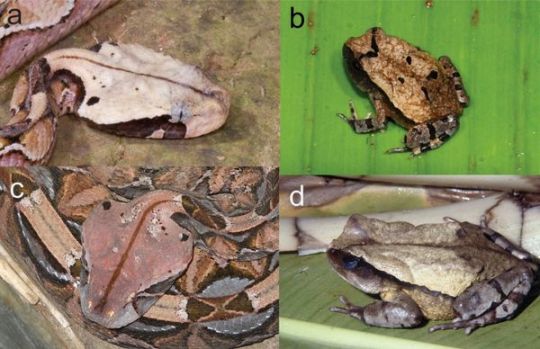
A remarkable example of suspected Batesian mimicry of Gaboon Vipers by Congolese Giant Toads
Eugene R. Vaughan, Mark S. Teshera, Chifundera Kusamba, Theresa R. Edmonston, and Eli Greenbaum
Abstract
Batesian mimicry is a phenomenon in nature whereby a non-toxic animal emulates a noxious one, seeking to deter predators by deception. This type of mimicry occurs in many animals, with numerous documented examples of invertebrates, harmless squamates, and even birds that mimic venomous snakes. However, no observations of anurans mimicking venomous snakes have been reported. Based on comparative data from colour pattern, morphology, geographic distribution and behaviour, we propose that the Congolese Giant Toad (Sclerophrys channingi), endemic to Democratic Republic of Congo, is a Batesian mimic of the geographically widespread Gaboon Viper (Bitis gabonica). Although the colour pattern similarity between these taxa is not an exact match, aposematism and precise imitation are not required for Batesian mimicry to be effective, especially when the model (B. gabonica) is dangerously venomous and carefully avoided by other vertebrates. Given the morphological similarity between S. channingi and two other African toad species (S. brauni and S. superciliaris) that are sympatric with B. gabonica and its sister taxon (B. rhinoceros), similar examples of Batesian mimicry are likely.
Read the paper here: A remarkable example of suspected Batesian mimicry of Gaboon Vipers (Reptilia: Viperidae: Bitis gabonica ) by Congolese Giant Toads (Amphibia: Bufonidae: Sclerophrys channingi ) | Request PDF (researchgate.net)
Journal of Natural History 53(29-30): 1853–1871. (2019)
doi: 10.1080/00222933.2019.1669730
#mimic#mimicry#biology#zoology#herpetology#toad#frog#amphibian#snake#viper#venomous#reptile#animals#nature#africa#science
88 notes
·
View notes
Photo
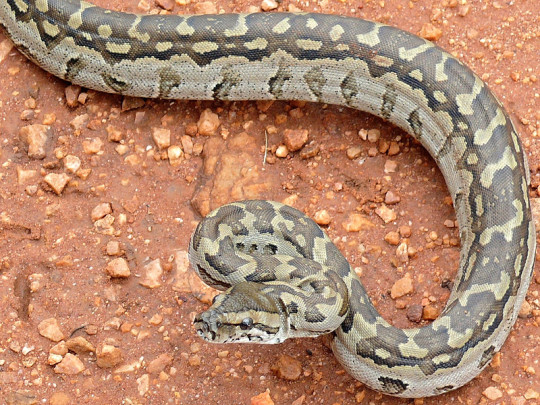
A juvenile Southern African rock python (Python natalensis) in South Africa
by Bernard Dupont
#southern african rock python#pythons#snakes#reptiles#juvenile#Python natalensis#python#pythonidae#serpentes#squamata#reptilia#chordata#wildlife: south africa#wildlife: africa
170 notes
·
View notes
Text

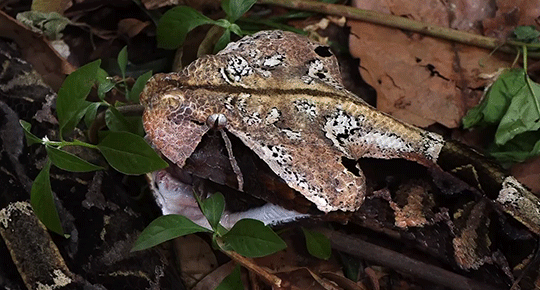

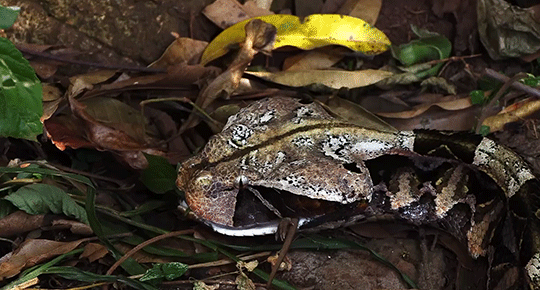

The longest fangs and highest venom yield of any venomous snake belong to the Gaboon viper. Unlike smaller, less strong species of viper they will bite their prey and hold on to it rather than letting it go and waiting for it to die. ©Living Zoology
122 notes
·
View notes
Text
i need to know who was lying to liquid because 😭😭😭
#my brother in christ do you know what a phenotype is 😭 clearly not#this is year 9 work come on i know you were like being evil in africa and all that but come on lad#mgs#mgs1#liquid snake#metal gear solid#metal gear
26 notes
·
View notes
Text

Female boomslang!!! I LOVE snakes and was super stoked when we spotted her because winter in South Africa is not the right season for herping 🐍
#my photography#animal photography#boomslang#snake#snake photography#south africa#caylen’s south africa adventure#kruger national park
24 notes
·
View notes
Text
If The Hunger Games series was released today, with The Ballad of Songbirds and Snakes released first, you wouldn't be able to use it as a discussion of colonialism and imperialism because you'd have entire circles of the internet dedicated to proving that the author is wrong and actually Snow is the true victim and screaming "Oh my god this is so disrespectful how dare you bring real world colonialism into your fandom discourse just to justify your faves. Stop moralizing fiction! Now let me tell you about how my meow meow isn't a colonizer and also Katniss is a crazy fascist."
Sidenote: The Hunger Games universe is an amazing distillation of the core-periphery model of colonization and imperialism and I will not shut up about it they should honestly teach it alongside Decolonialism 101 in schools which is why you know they won't.
#the hunger games#the ballad of songbirds and snakes#fandom discourse#what has happened to the internet#team black#shouldn't even need to be a thing why does it need to be a thing#i just want to talk about the patriarchy without willful misinterpretations you guys!#yes the way Panem works is a little hazy with the lines of colonialism/imperialism because it's lack a settler aspect#But the core-periphery exploitation aspect stands STRONG#In a lot of ways it's more comparable to European colonization of Africa rather than North America which is interesting
16 notes
·
View notes
Text

Hairy Bush Viper (Atheris hispida), family Viperidae, from central Africa
Venomous.
photograph by Mark Kostich
3K notes
·
View notes
Text
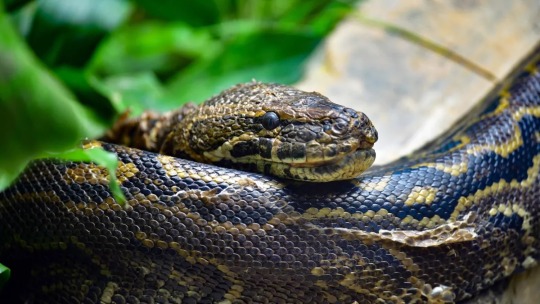
Central African rock python (up to 16.5 feet)
Central African rock pythons are Africa's largest snake, reaching lengths of 16.5 feet.
(Image credit: Michele D'Amico/Getty Images)
#michele d'amico#photographer#getty images#central african rock python#python#snake#africa#reptile#nature
18 notes
·
View notes
Text
" Drinking Dragons " //© Olivia Lundborg
© Original Audio
#West Africa#Africa#nature#Portraits#Wildlife#Snakes#Bush Viper#4K#8K#12K#fpv#reels#photography#aesthetics#wanderlust#explore#follow#discover
192 notes
·
View notes
Text

Snakes.
Cape Town, 2024.
#photographers on tumblr#original photographers#street photography#street#travel#color film#snakes#south africa#cape town
12 notes
·
View notes
Text

#showmax#africa#kenya#twende#madam mongoose#s1e1#stunt double trouble#reaction#gif#snakes#snake pit#trap door
3 notes
·
View notes
Photo

182 notes
·
View notes